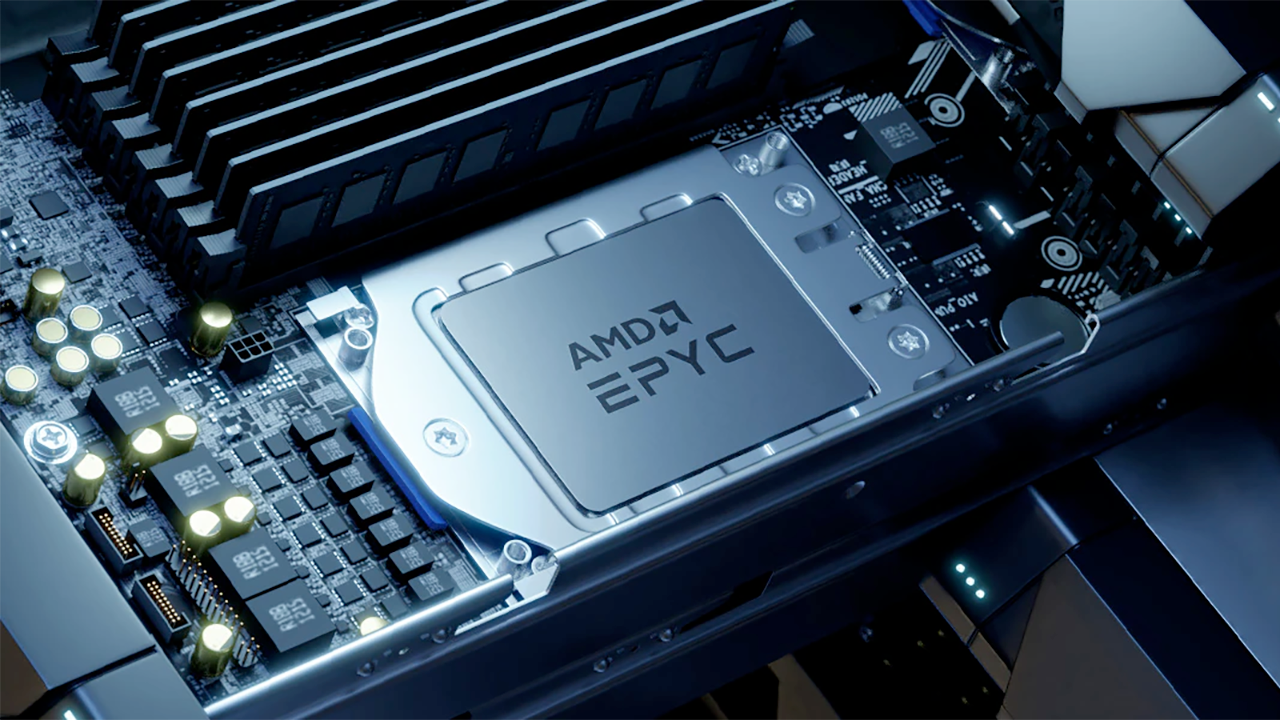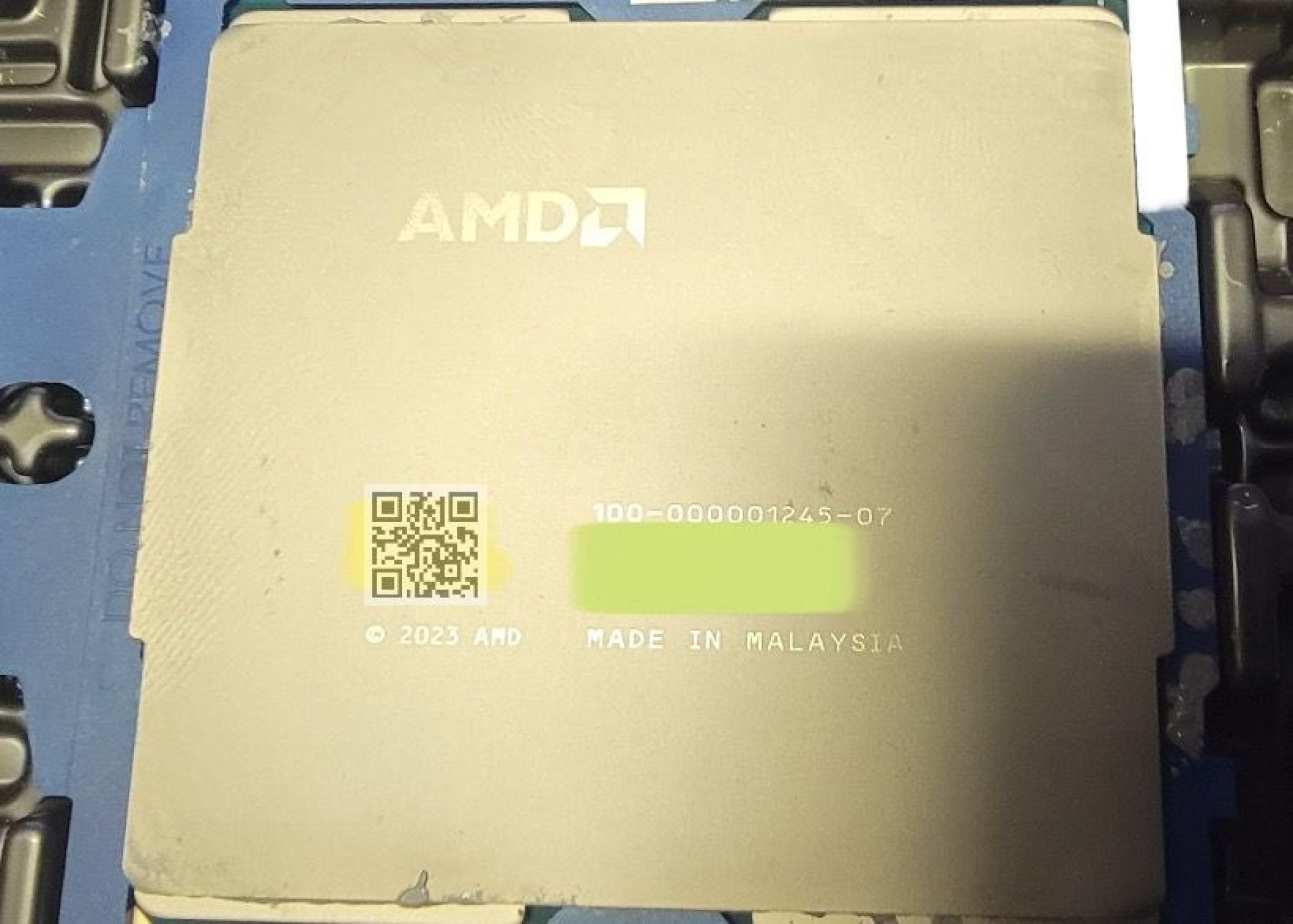AMD's next-gen server chips appear with 192 Zen 5c cores — EPYC Turin can also have up to 128 standard Zen 5 cores, new chips pictured and detailed in leak
And it features a new blue carrier.

Turin, AMD's upcoming Zen 5-based Epyc processor, has been pictured for the first time by leaker @yuuki_ans on X. The 5th-gen Epyc server and datacenter CPU is expected to launch in 2024.
The leak itself doesn't tell us a ton of new or unexpected info. Turin will use the same SP5 socket as 4th generation Epyc Genoa, Bergamo, and Siena, meaning it can slot into existing SP5 servers without needing a motherboard upgrade. It was expected AMD would continue using the SP5 socket with Turin, so this isn't exactly surprising. Turin also seemingly swaps out the old orange carrier for a blue one; it appears to be the same otherwise.
The leaker also shared two core layout diagrams of Turin, one with Zen 5 cores and one with denser Zen 5c cores. These diagrams are basically identical to Genoa and Bergamo, respectively, indicating no fundamental changes have been made with Zen 5. Interestingly, Turin continues to be the codename used for both variants instead of having two different codenames.
AMD ZEN5 EPYCTurin - ES2---It seems that there is no change in appearance with Genoa, but the color of the bracket has been changed.🤔🤔 pic.twitter.com/pVtAeh0XhtDecember 17, 2023
That this engineering sample exists at all can also imply quite a bit about where AMD is on the timeline for Turin and Zen 5's launch schedule. As a point of reference, Epyc Genoa was first pictured in April 2022, and it launched in November six months later. @yuuki_ans, the leaker in this story, also leaked an image of a Genoa CPU last year ahead of launch, except it was an actual model rather than an engineering sample. That leak came out in August, only two months before the November 10 launch date.
Get Tom's Hardware's best news and in-depth reviews, straight to your inbox.

Matthew Connatser is a freelancing writer for Tom's Hardware US. He writes articles about CPUs, GPUs, SSDs, and computers in general.
-
atomicWAR Replypeachpuff said:Intel: guys relax, let us catch up! :coldsweat:
I haven't seen AMD this on point since they first launched the AMD athlon 64/ FX 64 series. After years of competing well with the Athlons (post 1GHZ through Athlon XP), they hammered Intel with their 64 bit CPUs. Though sadly they also brought us our first 1 grand consumer CPU in the FX series (had 3 over my socket 939 days). So pricing had me pissed but Intel couldn't touch them in performance soooo...I paid up, single life and all back then.
While not all is lost for Intel, they certainly need to do a better job of catch up. Meteor Lake is honestly reminding me a bit of AMD's failed Piledriver. It may not run as hot and be as inefficient but it still feels like a solid step backwards with six P cores and lack luster IPC compared to the previous gen. Which makes me worry about Arrow lake and how Intel will fair over the next 5 years. I don't want to see another decade of +5-15% of gen on gen with the same core counts (or less ack). And we all know how little improvement we got with Raptor Lake/ Raptor lake part deux. -
thestryker Reply
FWIW there appears to be no P-core IPC difference between RPL and MTL. The maximum turbo is however lower which will undoubtedly lead to lower single threaded performance. Intel hasn't been speaking of improved P-cores as they appear to be roughly the same, but they have talked about improved E-core performance.atomicWAR said:While not all is lost for Intel, they certainly need to do a better job of catch up. Meteor Lake is honestly reminding me a bit of AMD's failed Piledriver. It may not run as hot and be as inefficient but it still feels like a solid step backwards with six P cores and lack luster IPC compared to the previous gen. -
bit_user Reply
In point of fact, the Alder Lake laptop SoCs also came with a max configuration of 6P + 8E. So, it's not actually a regression on core-count.atomicWAR said:Meteor Lake is honestly reminding me a bit of AMD's failed Piledriver. It may not run as hot and be as inefficient but it still feels like a solid step backwards with six P cores and lack luster IPC compared to the previous gen.
https://www.anandtech.com/show/17278/intel-launches-alder-lake-u-and-p-series-processors-ultraportable-laptops-coming-in-march
The way Intel delivered laptops with 8P cores was by repurposing desktop dies, which is their typical H/HX playbook. Because the S (i.e. desktop) version of Meteor Lake was cancelled, that explains why there's no 8P option for laptops.
As far as IPC, Crestmont did deliver improvements on that front. They say Redwood Cove was a "tock", and therefore didn't involve substantial design changes. Thus, any performance advantages would pretty much have to come from the node, but they claim they focused on efficiency, instead. I can attest to the fact that Alder Lake notebooks did indeed seem to suffer from an efficiency problem, just going by the terrible battery life of my work laptop.
Intel's own numbers make Arrow Lake sound pretty weak, in terms of P-core IPC gains.atomicWAR said:Which makes me worry about Arrow lake
Source: https://www.tomshardware.com/news/intel-raptor-lake-refresh-arrow-lake-cpu-performance-projections-leakedIf you look at the "(1-copy)" graphs, the Arrow Lake P-cores improve over Gen 13 Raptor Lake by only 4-8% (int) and 3-6% (fp) at ISO-power. So, that includes both IPC and clock speed. Remember they're comparing an Intel 7 vs. Intel 20A! That might be easier to take for one generation/node, but across two... definitely underwhelming.
15%? When did we ever get that? I can't think of a time between Sandybridge and Alder Lake that delivered even double-digit single-threaded improvements.atomicWAR said:and how Intel will fair over the next 5 years. I don't want to see another decade of +5-15% of gen on gen with the same core counts (or less ack).
Because Gen 14 is literally the same dies we had before! The only thing they actually refreshed was the product packaging!atomicWAR said:And we all know how little improvement we got with Raptor Lake/ Raptor lake part deux.
Intel didn't even bother to make a separate internal product category for them. If you look at ark.intel.com, the Gen 13 and Gen 14 (desktop) CPUs are all listed under Raptor Lake.
https://ark.intel.com/content/www/us/en/ark/products/codename/215599/products-formerly-raptor-lake.html -
TerryLaze Reply
If p-cores only improved by that little it would mean that intel managed to improve the e-cores performance by 10-15% under the same amount of power to get the n-copy results...that would actually be even more impressive.bit_user said:Intel's own numbers make Arrow Lake sound pretty weak, in terms of P-core IPC gains.
Source: https://www.tomshardware.com/news/intel-raptor-lake-refresh-arrow-lake-cpu-performance-projections-leakedIf you look at the "(1-copy)" graphs, the Arrow Lake P-cores improve over Gen 13 Raptor Lake by only 4-8% (int) and 3-6% (fp) at ISO-power. So, that includes both IPC and clock speed. Remember they're comparing an Intel 7 vs. Intel 20A! That might be easier to take for one generation/node, but across two... definitely underwhelming.
250W is not the ISO power for single thread! -
bit_user Reply
Yes, I agree that the bulk of the multithread improvement is probably coming from the E-cores. Although some of it could come from efficiency improvements in the P-cores, thereby allowing them to clock a little higher.TerryLaze said:If p-cores only improved by that little it would mean that intel managed to improve the e-cores performance by 10-15% under the same amount of power to get the n-copy results...that would actually be even more impressive.
Right. That wouldn't apply to the single-thread case, but it does mean that both estimates are with the CPU running under the same conditions.TerryLaze said:250W is not the ISO power for single thread! -
atomicWAR Reply
Most of those I was aware. Sorry hospitalized atm or I'd broke each bit down for reply but on my phone this will have to do.bit_user said:In point of fact, the Alder Lake laptop SoCs also came with a max configuration of 6P + 8E. So, it's not actually a regression on core-count.
https://www.anandtech.com/show/17278/intel-launches-alder-lake-u-and-p-series-processors-ultraportable-laptops-coming-in-march
The way Intel delivered laptops with 8P cores was by repurposing desktop dies, which is their typical H/HX playbook. Because the S (i.e. desktop) version of Meteor Lake was cancelled, that explains why there's no 8P option for laptops.
As far as IPC, Crestmont did deliver improvements on that front. They say Redwood Cove was a "tock", and therefore didn't involve substantial design changes. Thus, any performance advantages would pretty much have to come from the node, but they claim they focused on efficiency, instead. I can attest to the fact that Alder Lake notebooks did indeed seem to suffer from an efficiency problem, just going by the terrible battery life of my work laptop.
Intel's own numbers make Arrow Lake sound pretty weak, in terms of P-core IPC gains.
Source: https://www.tomshardware.com/news/intel-raptor-lake-refresh-arrow-lake-cpu-performance-projections-leakedIf you look at the "(1-copy)" graphs, the Arrow Lake P-cores improve over Gen 13 Raptor Lake by only 4-8% (int) and 3-6% (fp) at ISO-power. So, that includes both IPC and clock speed. Remember they're comparing an Intel 7 vs. Intel 20A! That might be easier to take for one generation/node, but across two... definitely underwhelming.
15%? When did we ever get that? I can't think of a time between Sandybridge and Alder Lake that delivered even double-digit single-threaded improvements.
Because Gen 14 is literally the same dies we had before! The only thing they actually refreshed was the product packaging!
Intel didn't even bother to make a separate internal product category for them. If you look at ark.intel.com, the Gen 13 and Gen 14 (desktop) CPUs are all listed under Raptor Lake.
https://ark.intel.com/content/www/us/en/ark/products/codename/215599/products-formerly-raptor-lake.html
IPC....yeah Intel own benches have been honest as such. I like they are hitting effeinacy as you stated previous gen 12/13th it was a problem. I just wanted more ipc than we got, as did Intel I imagine. But you work with what you got.
Core counts....yeah as soon as I read your post the light went on and I remembered reading as such. Still I'd preferred if they had 8c option.
15% increases...yes I was refering to the Sandy bridge through skylake(ish) era where we got small increases. My point was I didn't want to see that era return be Intel or AMD. If Intel stagnats I fear its a possibilty. Who knows though atp as it is all hypotheticals. Ideally this does not happen
12 to 13 to 14th gen...yeah I get its all mostly the same die (minus small changes). Its just unusual for Intel to run an arch this long. Don't get me wrong I love they gave 3(ish) gens on a platform similar to AMD but I'd would of liked it to have not have just been refreshes of an arch is all. Giving us more IPC with a new arch would have been more ideal but also out of the norm for intel so I get it. All of which gives me the feeling Intel is struggling more than they'd like which is again where I worry a 15% on gen could come back be it out of need (ipc clock regressions on smaller nodes for example) or lack of innovation. ...again hope I am wrong.
I think I covered things. Please feel free to affirm or poke holes in said statement. And as always thanks for your input and reply. -
bit_user Reply
Yeesh. Best wishes, man!atomicWAR said:Most of those I was aware. Sorry hospitalized atm or I'd broke each bit down for reply but on my phone this will have to do.
One thing I forgot to mention was APX, which Intel claims is good for something like 10% IPC, IIRC. They didn't say when it's coming, but maybe in 2026?atomicWAR said:I just wanted more ipc than we got, as did Intel I imagine.
As do they, I'm sure. But, Arrow Lake will be here soon.atomicWAR said:Still I'd preferred if they had 8c option.
Yeah, IPC is a game of diminishing returns, though. I keep expecting us to hit a wall, so I'm never surprised when a new generation comes in low, on that metric.atomicWAR said:15% increases...yes I was refering to the Sandy bridge through skylake(ish) era where we got small increases. My point was I didn't want to see that era return be Intel or AMD. If Intel stagnats I fear its a possibilty. Who knows though atp as it is all hypotheticals. Ideally this does not happen
Anyway, Zen 5 is rumored to have some nice IPC gains.
No... I think all 13th and 14th gen CPUs are made from one of the following dies:atomicWAR said:12 to 13 to 14th gen...yeah I get its all mostly the same die (minus small changes).
Alder Lake stepping C0: 8P + 8E
Alder Lake stepping H0: 6P + 0E
Raptor Lake stepping B0: 8P + 16E
That's it. There are no other dies! They did not make any new dies, for 14th gen! They programmed in a different CPUID value, in the on-chip ROM, and the motherboard's BIOS simply checks it to see what clock speeds to allow.
You can see which CPU models are made from which dies, here:
https://www.gigabyte.com/Motherboard/Z790-AORUS-ELITE-X-AX/support#support-cpu
